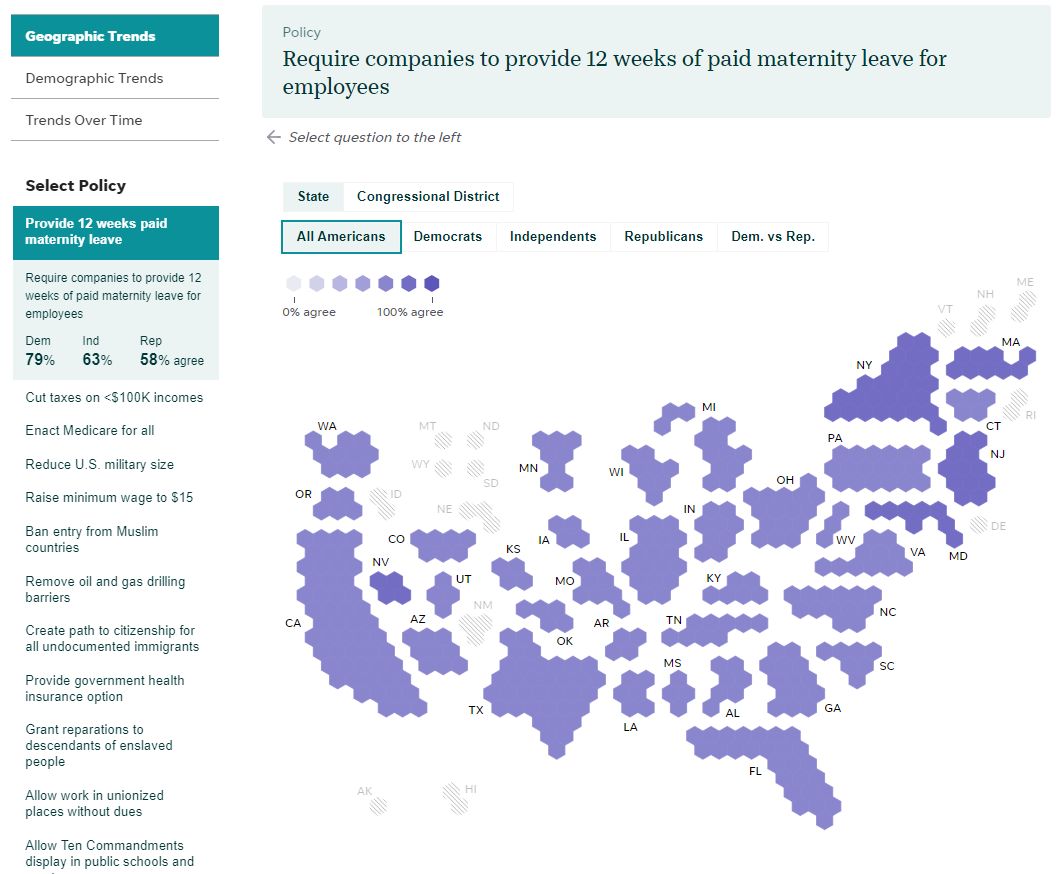
Democracy Fund + UCLA Nationscape and USA Today
On the Nationscape Insights website, readers can analyze - by geography and political party - support for ideas like requiring companies to provide 12 weeks of paid maternity leave.
Americans' attitudes about police changed rapidly following the death of George Floyd and the nationwide protests that ensued.
Results from the Democracy Fund + UCLA Nationscape survey, published in USA Today, found that the number of people with somewhat favorable or very favorable perceptions of the police declined across all racial groups over the past two weeks, including a drop from 72% to 61% among white respondents. Among Black respondents, 38% said they had a somewhat or very favorable view of police, down 9 percentage points from the previous week.
The figures are based on a survey of 6,000 people from May 28 to June 3, compared with the previous week.
Nationscape is being conducted by UCLA political science professors Lynn Vavreck and Chris Tausanovitch in partnership with the Washington, D.C.-based Democracy Fund Voter Study Group. The surveys are fielded by Lucid, a market research platform.
The percentage of Black Americans with a somewhat or very unfavorable view of police increased by 10 percentage points to 54%. Favorability perceptions also declined among Asian and Pacific Islanders (to 51%, down 14 points) and Latinos (to 52%, down 6 points).
The survey project has also launched Nationscape Insights, an interactive dashboard on USA Today's website, that allows readers to analyze how Democratic, Republican and independent respondents feel about issues like raising the minimum wage, creating a path to citizenship for undocumented people, capping carbon emissions and paid maternity leave.
The dashboard will be updated weekly; it eventually will include findings from all 500,000 interviews the project intends to complete before the November election.
"A good survey is like a good conversation — it's about listening to people — and we've heard from hundreds of thousands of people since last July," said Vavreck, who holds the UCLA Marvin Hoffenberg Chair in American Politics and Public Policy. "The data tell us stories about things Americans disagree on but also about points of agreement.
"As people use this new data visualization to interact with our data, we think they will start to see large areas of agreement — on things like universal background checks for gun purchases or providing paid maternity leave — which may help enact legislation that has broad benefits to all Americans."
The Nationscape project's massive sample size enables researchers to measure and better understand attitudes among demographic groups that are not well-represented in most national polls — a feature Vavreck said is especially important in light of the racial justice, public health and economic crises facing the nation today.
For example, Nationscape Insights can provide a closer look at the concerns of 18-to-29-year-old Black voters on key issues heading into the 2020 election:
- Raising the minimum wage to $15 per hour. 72% of young Black respondents support the idea, compared to 61% of all voters.
- Building a southern border wall. 62% of young Black oppose the plan, compared to 48% of all voters.
- Ensure that all students can graduate from state colleges debt free. 75% of young Black voters support the idea, compared to 59% of all Americans.
"Nationscape Insights with USA Today creates a window into the data that will allow every researcher, reporter and armchair pundit to do their own analysis of this important moment in our nation's history," said Alicia Kolar Prevost, director of Democracy Fund's Voter Study Group.






